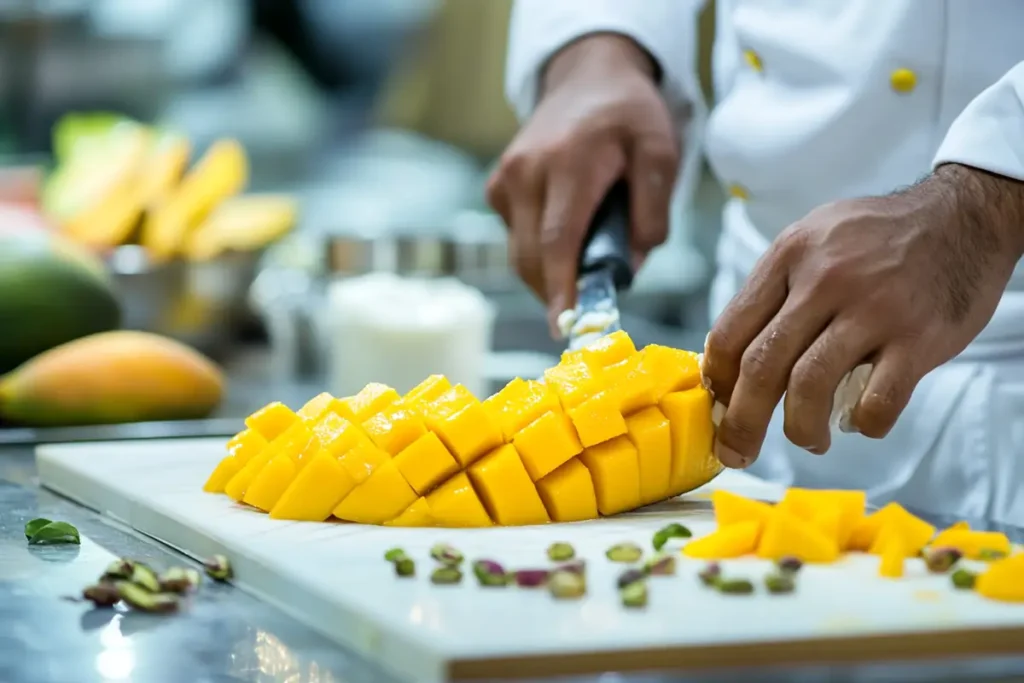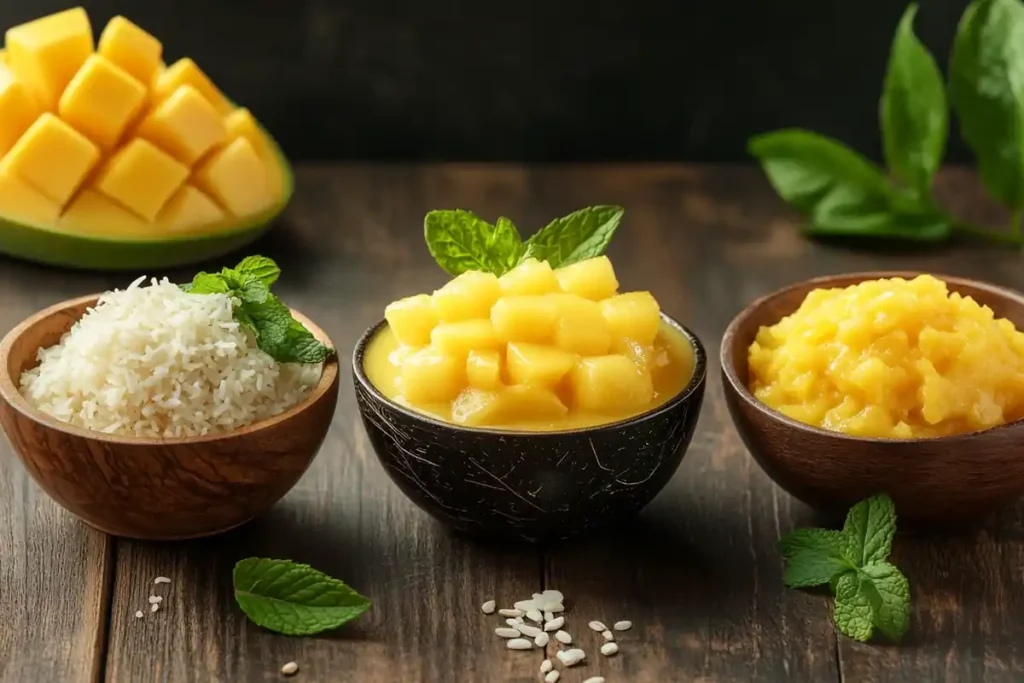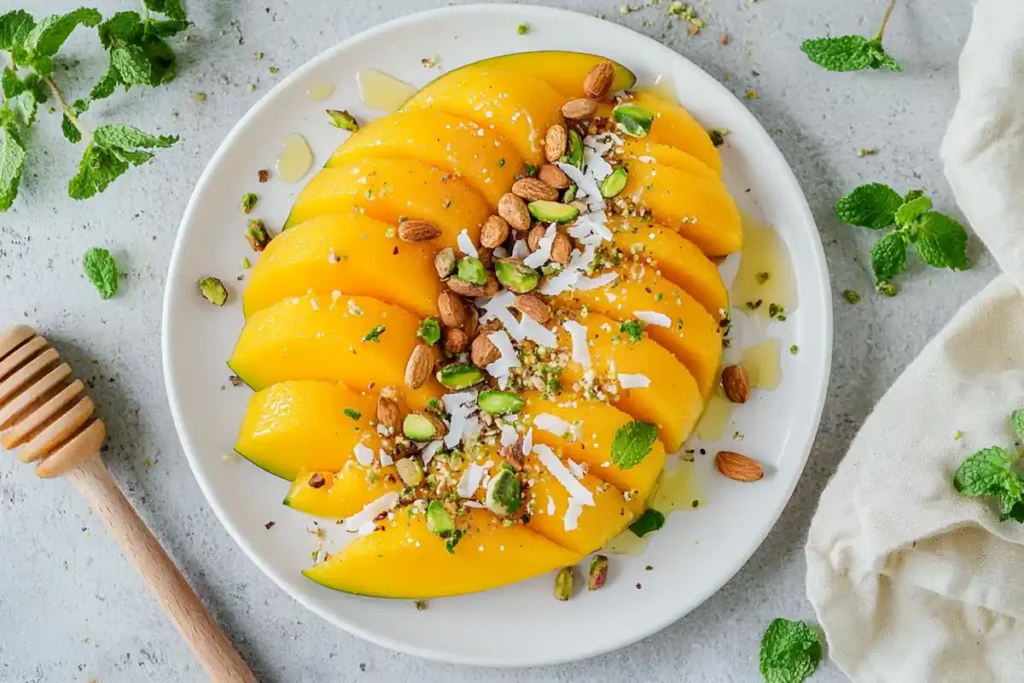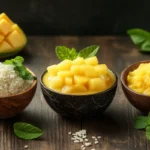Mangoes, the luscious “king of fruits,” are the heart of every mango dessert recipe, infusing dishes with their natural sweetness and vibrant tropical flavor. Whether you’re crafting a creamy mango mousse, refreshing sorbet, or traditional mango pudding, this guide is your ultimate resource for perfecting these treats. From selecting the best mangoes to exploring unique global variations, you’ll learn everything you need to create unforgettable desserts. Let’s dive into the irresistible world of mango dessert recipes!
Best Mango Dessert Recipe for Every Occasion
What Makes Mango Desserts Special?
Mango desserts are cherished worldwide, and it’s no wonder why. Their natural sweetness blends effortlessly with various ingredients, from cream to coconut, making them versatile enough to satisfy every palate. Mangoes also bring a burst of tropical flair, turning even simple recipes into decadent treats. Whether it’s a festive gathering or a quiet evening at home, mango desserts feel both indulgent and comforting.
Why Mango is a Versatile Dessert Ingredient
Oh, the possibilities! Mangoes can be pureed, sliced, diced, or even frozen to create a range of textures in desserts. Their flavor complements both sweet and tangy elements, making them ideal for dishes like puddings, sorbets, and cheesecakes. Plus, they pair wonderfully with other tropical fruits, nuts, and even herbs like mint and basil.
Preview of the Recipe & Its Variations
In this article, we’ll uncover an easy-to-follow mango dessert recipe that’s adaptable to suit every occasion. From a quick no-bake cheesecake to a crowd-pleasing mango mousse, you’ll discover recipes that are not only delicious but also simple to prepare. Ready to explore? Let’s begin!
Essential Ingredients and Preparations
Key Ingredients for the Perfect Mango Dessert

Creating a perfect mango dessert recipe starts with selecting high-quality ingredients. Mangoes, of course, are the star of the show, but let’s not overlook the supporting cast that brings the dish together.
- Fresh Mango Varieties and Their Uses
Not all mangoes are created equal! Varieties like Alphonso, Ataulfo, and Haden are prized for their sweetness and creamy texture, making them ideal for desserts. If you prefer a tangy twist, go for Tommy Atkins or Kent mangoes. Remember, ripe mangoes should yield slightly to pressure and exude a sweet aroma. - Alternative Ingredients for Mango Dessert
When fresh mangoes aren’t available, canned mango pulp or frozen mango chunks can step in. These substitutes maintain the flavor while offering convenience, especially for out-of-season cravings. Adding sweeteners like honey or maple syrup can also elevate the dish. - Essential Kitchen Tools for Mango Recipes
To whip up the perfect mango dessert, stock your kitchen with a few handy tools. A sharp knife for peeling and slicing, a blender for creating smooth purees, and measuring cups for accuracy are must-haves. For fancier recipes, springform pans and piping bags can take your presentation to the next level.
Tips for Selecting the Best Mangoes
- Seasonal Availability
Mangoes shine brightest during their peak seasons, typically from late spring to early summer. Buying them fresh during this time ensures maximum flavor. - How to Test for Ripeness
Here’s a tip: don’t rely solely on color. Gently squeeze the mango—it should give slightly under your fingers. Additionally, a fragrant smell near the stem indicates ripeness. Avoid mangoes with wrinkles or dark spots, as these may be overripe.
Armed with these tips and tools, you’re all set to move to the fun part: making your mango dessert recipe!
Step-by-Step Mango Dessert Recipe
How to Make the Ultimate Mango Dessert
Creating a delightful mango dessert recipe doesn’t have to be daunting. This step-by-step guide will help you craft a dessert that’s both visually stunning and irresistibly tasty.
- Preparation Time, Cook Time, and Serving Suggestions
- Prep Time: 20 minutes
- Cook Time: 10 minutes (if required)
- Servings: 4-6
Step 1: Prepping Your Mangoes
Begin by washing your mangoes thoroughly. Peel the skin using a sharp knife or vegetable peeler, then slice the flesh away from the pit. For presentation, cut some of the mango into neat cubes or thin slices and set aside. Blend the rest into a smooth puree, ensuring a rich, velvety texture.
Step 2: Creating the Dessert Base
Depending on the dessert you’re making, the base will vary. For a mousse, whip heavy cream with sugar until soft peaks form, then fold in the mango puree. If you’re making a cheesecake, combine crushed graham crackers with melted butter and press into a pan to form the crust.
Step 3: Layering and Assembling Your Dessert
Here’s where you let your creativity shine! Layer mango puree, cream, or custard in glasses or bowls for a parfait. For a no-bake cheesecake, pour the mango mixture over the crust and refrigerate until set. Want a simpler approach? Spoon the mango puree over ice cream or yogurt for a quick treat.
Step 4: Adding Final Touches and Garnishes
The finishing touches can transform your dessert. Top your creation with fresh mango cubes, a sprinkle of crushed pistachios, or a drizzle of honey. Garnishes like mint leaves or edible flowers can add a touch of elegance.
Variations of Mango Dessert Recipes
- No-Bake Mango Cheesecake
Combine cream cheese, whipped cream, sugar, and mango puree for a no-bake cheesecake that’s creamy and refreshing. - Vegan Mango Mousse
Swap heavy cream for coconut cream and sweeten with maple syrup for a plant-based dessert that’s just as indulgent. - Mango Sorbet
Blend mango puree with a splash of lime juice and freeze for a light and tangy sorbet, perfect for summer.
With these easy-to-follow steps and variations, your mango dessert will be a guaranteed hit at any gathering!
Popular Mango Dessert Recipes Worldwide

Iconic Mango Desserts Across the Globe
Mangoes are celebrated in desserts worldwide, each culture putting its unique spin on this versatile fruit. These iconic recipes showcase how mangoes can be used in diverse and delightful ways.
- Mango Sticky Rice (Thailand)
A beloved Thai dessert, mango sticky rice pairs the creamy richness of coconut milk-infused sticky rice with the sweetness of fresh mango slices. It’s often topped with a drizzle of coconut cream and a sprinkle of sesame seeds, creating a heavenly blend of textures and flavors. - Mango Pudding (China)
This silky dessert is a favorite in Cantonese cuisine. Made with mango puree, evaporated milk, and gelatin, mango pudding has a smooth, custard-like texture. It’s typically served chilled and garnished with fresh mango chunks for added sweetness. - Aamras (India)
A classic Indian dessert, aamras is essentially mango pulp blended with sugar and a hint of cardamom. It’s often served with puris (fried bread) or enjoyed as a standalone treat. Alphonso mangoes are the preferred variety for their intense flavor and color. - Mango Sago (Philippines)
This refreshing dessert combines mangoes with small tapioca pearls (sago) and creamy evaporated milk. It’s a light, tropical dessert that’s perfect for hot days and is served chilled for maximum refreshment.
Exploring the Origin of Mango Pudding
Mango pudding’s roots can be traced back to Hong Kong, where it gained popularity as a fusion of tropical flavors and classic pudding techniques. The dessert’s appeal lies in its simplicity and adaptability—allowing chefs to experiment with flavors like coconut or passion fruit. Over time, mango pudding has become a favorite not just in Asia but around the world.
These global favorites highlight how mango dessert recipes transcend borders, proving their universal charm and adaptability!
Pairing Mango with Other Ingredients

What Mixes Well with Mangoes?
Mangoes shine brightest when paired with ingredients that enhance their natural sweetness and tropical charm. Let’s explore some winning combinations that can elevate any mango dessert recipe.
- Tropical Fruits (Pineapple, Coconut)
Mangoes blend effortlessly with other tropical flavors like pineapple and coconut. Pineapple adds a tangy kick, while coconut brings a creamy richness, making them ideal companions in smoothies, mousses, or trifles. - Nuts (Almonds, Pistachios)
The crunchy texture of nuts like almonds and pistachios complements the softness of mangoes. Whether sprinkled as a topping or blended into a dessert, these nuts add a delightful contrast that’s both textural and flavorful. - Herbs and Spices (Mint, Cardamom)
Fresh herbs like mint provide a refreshing burst of flavor that cuts through the sweetness of mango. Similarly, warm spices like cardamom and cinnamon add depth, making the dessert feel cozy yet exotic. - Sweeteners and Dairy Products (Honey, Cream)
For a touch of indulgence, combine mangoes with dairy products like cream, yogurt, or condensed milk. Sweeteners like honey or maple syrup amplify mango’s natural sugars without overpowering its flavor.
What Pairs Well with Mango in Baking?
When baking with mangoes, it’s essential to think about complementary flavors that enhance the overall experience:
- Flavored Crusts (Graham Crackers, Shortbread)
A graham cracker or buttery shortbread crust pairs beautifully with mango-based fillings, providing a satisfying crunch to contrast the fruit’s smooth texture. - Toppings (Coconut Flakes, Chocolate Drizzle)
To add flair and flavor, top your baked mango desserts with toasted coconut flakes or a delicate drizzle of dark chocolate. These toppings not only enhance visual appeal but also add layers of taste that keep each bite exciting.
By pairing mango with the right ingredients, you can create dynamic, mouthwatering desserts that are sure to impress!
Expert Tips and Tricks for Mango Desserts
Pro Tips for Perfecting Your Mango Dessert Recipe
Crafting a memorable mango dessert recipe involves more than following instructions; it’s about understanding the nuances that make this tropical fruit shine. Here are some expert tips to ensure your desserts turn out flawlessly every time.
- Balancing Sweetness and Tartness
Mangoes can vary in sweetness depending on their variety and ripeness. If your mangoes are overly sweet, balance them with a dash of lime or lemon juice. For tangier mangoes, a bit of honey or sugar can smooth out the flavor. - Use Ripe, but Not Overripe, Mangoes
Ripe mangoes are perfect for desserts as they’re naturally sweet and juicy. However, overripe mangoes can become mushy and overpowering. Always aim for mangoes that are firm yet give slightly when pressed. - Storing and Serving Mango-Based Desserts
Store mango desserts in airtight containers to maintain freshness and prevent oxidation. Always chill recipes like mousses, puddings, and no-bake cheesecakes for at least 2-3 hours before serving. A chilled mango dessert not only enhances flavor but also improves texture. - Play with Textures
For added interest, incorporate a variety of textures in your dessert. Layer creamy mango puree with crunchy nuts, crispy cookies, or chewy tapioca pearls for a dessert that surprises with every bite. - Presentation Matters
A visually appealing dessert is half the battle won. Use transparent glasses for layered parfaits or decorate with fresh herbs, edible flowers, or colorful toppings like pomegranate seeds.
These tips will take your mango dessert recipes from good to absolutely unforgettable!
Health Benefits of Mango Desserts
Why Mango Desserts Can Be Guilt-Free
Mangoes are not just delicious; they’re also packed with nutrients, making them a wholesome choice for desserts. When paired with the right ingredients, mango dessert recipes can be indulgent yet nutritious. Here’s why you can enjoy these treats guilt-free!
- Nutritional Value of Mangoes
Mangoes are rich in essential vitamins and minerals. They’re a powerhouse of vitamin C, which supports immune health, and vitamin A, which promotes good vision. Additionally, mangoes contain dietary fiber, which aids digestion, and antioxidants that help fight free radicals. - Low-Calorie Sweetness
Compared to processed sugar, the natural sweetness of mangoes offers a healthier alternative for desserts. With fewer calories and no artificial additives, mangoes can help satisfy your sweet cravings without the guilt.
How to Make Healthier Versions of Mango Desserts
- Swap Heavy Cream for Greek Yogurt
Greek yogurt is a protein-rich, low-fat substitute that pairs wonderfully with mango. Use it in place of heavy cream for a lighter mousse or parfait. - Opt for Natural Sweeteners
Instead of refined sugar, try natural sweeteners like honey, maple syrup, or stevia. These options enhance the flavor of mango without spiking your calorie intake. - Incorporate Whole Grains
For baked mango desserts, use whole-grain flours or oats to boost fiber content. A whole-grain crust in a mango tart or crumble is both hearty and healthy. - Add Superfood Toppings
Garnish your desserts with nutrient-dense toppings like chia seeds, flaxseeds, or unsweetened coconut flakes. These additions not only improve the dessert’s nutritional profile but also add interesting textures.
Mango desserts can truly be a treat for your taste buds and your body, proving that indulgence doesn’t always mean compromise!
Common Mistakes and How to Avoid Them
Pitfalls to Avoid When Making Mango Desserts
Even the most straightforward mango dessert recipes can go awry if you’re not careful. Let’s look at some common mistakes and how you can sidestep them to ensure a successful, stress-free dessert-making experience.
- Using Overripe or Underripe Mangoes
Overripe mangoes can become too mushy, while underripe ones might be too firm and lack sweetness. Always check for ripeness by pressing the fruit gently and ensuring it has a pleasant aroma. - Incorrect Measurements
Eyeballing ingredient quantities can lead to desserts that are either too runny or overly dense. Use measuring cups and spoons to achieve the perfect balance of flavors and textures. For example, a mango mousse with too much puree can become heavy instead of light and airy. - Skipping the Chilling Process
Many mango desserts, such as puddings and cheesecakes, require chilling to set properly. Rushing the process can result in a dessert that’s too soft or falls apart when served. Always allow enough time for chilling, typically 2-4 hours or even overnight. - Improper Storage
Leaving your mango desserts exposed to air can cause them to dry out or lose flavor. Use airtight containers, and if your dessert has layers or garnishes, separate them to maintain their integrity. - Overloading with Garnishes
While garnishes like nuts, coconut, or chocolate can elevate a dessert’s look, too many toppings can overpower the mango’s natural flavor. Keep garnishes simple and complementary to highlight the fruit’s sweetness.
Frequently Asked Questions (FAQs)
How do you make Jamie Oliver mango dessert?
Jamie Oliver’s mango dessert recipes often emphasize simplicity and freshness. For a classic mango dessert, slice ripe mangoes into thin pieces and layer them with whipped cream, Greek yogurt, or mascarpone cheese. Drizzle with a hint of honey or lime juice for added flavor. Finish with a garnish of fresh mint leaves or a sprinkle of crushed nuts.
What is the origin of mango pudding?
Mango pudding originated in Hong Kong as a fusion of tropical flavors and classic dessert techniques. It was inspired by the abundance of mangoes in Asia and the creamy texture of Western puddings. Over time, it became a staple in Cantonese cuisine and spread worldwide as a beloved dessert.
What mixes well with mangoes?
Mangoes pair beautifully with tropical fruits like pineapple, banana, and coconut. They also complement nuts such as almonds and pistachios, as well as herbs like mint and basil. Sweeteners like honey or natural syrups further enhance mango’s flavor, making it versatile for both simple and elaborate desserts.
What pairs well with mango in baking?
In baking, mangoes go well with graham cracker or shortbread crusts, adding a buttery crunch to the dessert. Coconut flakes, dark chocolate, or a hint of cinnamon can act as perfect toppings or flavor enhancers. These pairings bring out the mango’s natural sweetness while adding depth to baked treats.
Print
Mango Delight Dessert
- Total Time: 15 minutes
- Yield: 4 servings 1x
Description
A creamy and luscious mango dessert that’s perfect for any occasion. This tropical treat combines the sweetness of ripe mangoes with velvety cream, creating a light and refreshing dessert that will transport you to a sunny paradise. It’s easy to make and a guaranteed crowd-pleaser.
Ingredients
- For the mango layer:
- 2 large ripe mangoes, peeled and cubed
- 2 tablespoons honey (optional, adjust based on mango sweetness)
- 1 teaspoon fresh lemon juice
- For the cream layer:
- 1 cup heavy cream (chilled)
- 2 tablespoons powdered sugar
- 1 teaspoon pure vanilla extract
- Toppings:
- Diced mango (for garnish)
- Chopped pistachios or almonds (optional)
- Mint leaves (optional)
Instructions
- Prepare the Mango Layer:
- In a blender, combine the mango cubes, honey (if using), and lemon juice. Blend until smooth and creamy. Set aside.
- Whip the Cream:
- In a chilled mixing bowl, whisk the heavy cream, powdered sugar, and vanilla extract until soft peaks form. Be careful not to overwhip.
- Assemble the Dessert:
- In serving glasses or bowls, start by adding a layer of the mango puree.
- Add a generous layer of whipped cream on top.
- Repeat the layers until the glasses are full, finishing with a dollop of whipped cream.
- Garnish and Serve:
- Top with diced mangoes, a sprinkle of pistachios or almonds, and a mint leaf for a fresh touch.
- Chill the dessert in the refrigerator for at least 1 hour before serving for the best flavor and texture.
Notes
- For a dairy-free option, use coconut cream instead of heavy cream.
- If fresh mangoes aren’t available, you can use canned mango pulp or frozen mango chunks (thaw first).
- This dessert can be made up to a day in advance. Keep it refrigerated and assemble just before serving.
- Prep Time: 15 minutes
- Cook Time: 0 minutes
- Category: Dessert
- Method: No-bake
- Cuisine: Tropical
Nutrition
- Calories: 220
- Sugar: 20g
- Sodium: 25mg
- Fat: 12g
- Saturated Fat: 7g
- Unsaturated Fat: 4g
- Trans Fat: 0g
- Carbohydrates: 26g
- Fiber: 2g
- Protein: 2g
- Cholesterol: 40mg
Keywords: mango dessert, no-bake mango dessert, tropical dessert, mango cream dessert

